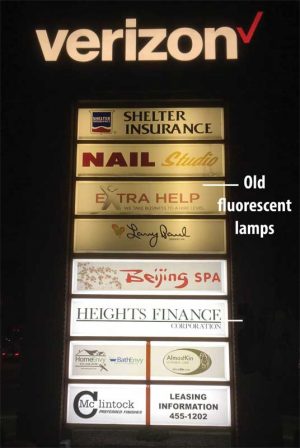Calculating ROI on retrofit installations

With LEDs, the beams are more directional, which allows maximum sign illumination with a minimum number of light sources.
Many LED manufacturers can provide an ROI calculator. The author’s company has a simple online calculator that provides a custom ROI to sign businesses, which they, in turn, can directly present to customers. It even allows professionals to adjust their material markup and input their installation costs. The output includes annual savings for the customer and an ROI given over a specific time period.
There are three key variables that should be researched prior to bidding a T12-to-LED retrofit.
Evaluate the site
Sign professionals should begin by asking themselves: “Is this a difficult-to-service area (i.e. one that requires special trucks
or equipment for servicing) or one with high-maintenance costs due to the remoteness of the location or limited access?” Other questions to consider are whether or not the client has time restrictions for the installer to be on-site and how it would impact their work. Finally, one must evaluate access for future maintenance jobs before making any suggestions. It often makes sense to recommend a system that has higher upfront costs beforehand, to prevent expensive service calls in the future.
Research code restrictions
Many cities and municipalities have restrictions on new signage, which may apply to a retrofit as well—especially if the sign is older and, therefore, ‘grandfathered.’ It is important to understand national and local codes and any other special electrical requirements put in place by the city or municipality. In some cases, a new sign may require extensive electrical fixtures that may exceed the budget.
Gather maintenance data and energy costs
One may not be servicing the sign, but as an expert, they may have a rough idea of the maintenance costs of the site. If one has already serviced the sign before, they should have the client’s maintenance history. If one is unsure of ongoing costs, they can check with customers, who would be happy to share their records during the survey—especially if one explains they need this data to conduct a proper assessment to guide them toward the best solution. During the survey, one should also gather other necessary information: current illumination source, wattage, energy costs, and hours of operation. This data is critical in providing a complete ROI analysis to the client. Many LED and other lighting manufacturers have off-the-shelf calculators to help sign companies provide a complete returns analysis to their customers.
Today, changing illuminated signs from T12 to LED is easier and more cost-effective than ever. Understanding the dynamics of the site, educating customers on ROI data, and communicating clearly with clients will ensure a great experience and a sign that performs well for years to come.
Bryan Vincent is an expert in the field of solid-state lighting and electronic materials. He has dedicated the past 10 years to developing light-emitting diode (LED) solutions specific to the sign industry. He co-founded Principal LED with his brother Blake Vincent. Bryan has a bachelor’s degree in chemistry and a PhD in chemistry/materials science. For more information, visit www.p-led.com.





